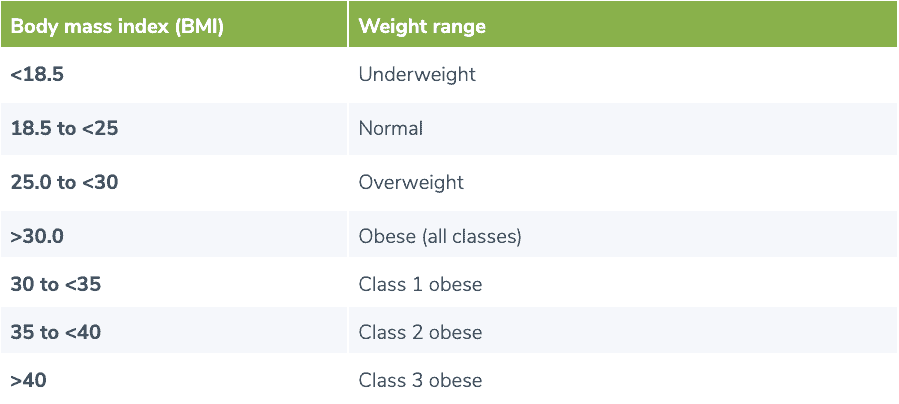What is obesity?
Overweight and obesity are characterized by having a higher than normal weight. (12) A body mass index (BMI) over 30 is considered to be in the obese weight range. BMI is a tool used to screen for overweight or obesity. BMI is calculated by an individual’s weight in kilograms divided by the square of height in meters. (4) An online BMI calculator may be used to determine your BMI. (7) The following table outlines the BMI associated with each weight range for adults.
Causes and risk factors for obesity
Causes and risk factors for obesity include:
- Certain medical conditions (e.g., Cushing’s disease, polycystic ovary syndrome (PCOS)) (8)
- Certain medications (e.g., antidepressants, steroids) (8)
- Genetic predisposition to obesity (8)
- Physical inactivity (12)
- Poor eating patterns (e.g., consuming high-calorie, low-nutrient foods) (12)
- Poor sleep habits (12)
- Screen time (e.g., computer, smartphone, television) (12)
- Socioeconomic factors (e.g., lower educational attainment) (5)
Further, the causes of obesity in children may include environmental risk factors. Schools, child care centers, and communities may influence eating and physical activity habits depending on the foods and activity opportunities provided. Childhood obesity also increases the risk of obesity later in life. (3)
Signs, symptoms, and complications of obesity
Obesity results in physical changes, including excessive adipose (fat) tissue, particularly in the abdominal region. (9) Individuals with obesity may experience a low quality of life, pain, limited physical mobility, breathing problems, and mental illnesses (e.g., anxiety, depression). (8) Further, obesity increases the risk of several health conditions, such as cardiovascular disease, type 2 diabetes, osteoarthritis, certain cancers, (8) and non-alcoholic fatty liver disease. (9)
In addition to the health conditions listed above, obesity may be related to oral health by increasing the risk of certain dental issues.
What is tooth wear?
Characterized by the loss of hard dental tissue, tooth wear may result from different processes, including:
- Abrasion, the interaction between teeth and other materials
- Attrition, the contact between teeth
- Erosion, the dissolution of tissue by acidic substances (10)
These three processes can occur on their own or in combination. Tooth enamel that has been eroded is more susceptible to further damage through abrasion and attrition. (11) Tooth wear may result in dental hypersensitivity, pain, and aesthetic changes to the teeth. (2) Research suggests that the prevalence of tooth wear is increasing, and there may be an association between obesity and tooth wear. (10)

Causes and risk factors for erosive tooth wear
Several factors have been identified that may increase the risk of erosive tooth wear, including:
- Anorexia nervosa (11)
- Certain medications (e.g., anti-nausea, antihistamines, tranquilizers) (11)
- Excess intake of acidic foods and beverages (2) (e.g., alcohol, candy, herbal teas, sports drinks) (11)
- Gastroesophageal reflux disease (GERD) (2)
- Overweight, obesity (10)
- Predisposition to erosion (2)
- Vomiting (2)
Obesity and tooth wear: what’s the connection?
A confounding factor between obesity and excessive tooth wear is sugar-sweetened acidic drinks, such as acidic fruit juices and soft drinks. The sugar found in these drinks may contribute to weight gain and obesity, while their acid content may result in tooth wear. (10) Certain bacteria in the mouth have been found to digest dietary sugars and produce enamel-demineralizing acids, further decaying teeth.
A recent study examined the association between BMI and tooth wear in adults using survey data from over 3,500 adults. The researchers found that obesity was positively associated with tooth wear. Interestingly, it appears that this association was only partly accounted for by sugar-sweetened acidic drinks, suggesting there may be other factors involved. (10)
Similarly, another study analyzed tooth wear in 223 overweight and obese children and teens aged four to 17. The study suggests that, compared with normal-weight children, a higher BMI is associated with a higher risk of tooth wear and dental caries. The consumption of erosive beverages and snacks was identified as a significant risk factor for erosive tooth wear. (17)
How to address obesity-related tooth wear
Approaches to prevent or address erosive tooth wear include appropriate dental care, dietary modifications, and dietary supplements. It’s important to note that individuals who have erosion from intrinsic causes, such as anorexia nervosa or reflux, may require psychological support, medication, or surgical interventions. (11)
Dental care
According to recommendations made in a study published by the American Journal of Dentistry, certain dental care measures may help prevent dental erosion. These include using a soft toothbrush, fluoride dental treatments, using a low abrasion fluoride-containing toothpaste, and avoiding brushing teeth immediately following an acidic meal or vomiting. Additionally, it was recommended to stimulate saliva after the intake of acidic food or drinks, which can be achieved by chewing gum or using lozenges. (11)

Dietary modifications
To prevent erosive tooth wear, the foods and beverages to limit include:- Acidic fruit juices (e.g., orange juice, grapefruit juice, lemonade) (15)
- Carbonated drinks (e.g., soft drinks) (15)
- Sweets and acidic snacks (e.g., sour candy, popsicles) (15)
- Certain dietary supplements (e.g., effervescent vitamin C tablets) (11)
- Vinegar (16)
- Calcium-rich foods (e.g., milk, yogurt) (2)(15)
- Fiber, which may decrease the absorption of sugar from other foods (16) (e.g., vegetables, legumes, nuts, seeds) (18)
- Whole grains, which require more mastication (chewing) than flour-based products, stimulating saliva (16) (e.g., brown rice, quinoa, oat groats) (18)
- Sufficient vitamin A intake (16) (e.g., dairy, eggs, liver, sweet potato) (13)
- Sufficient vitamin D intake (16) (e.g., fish, chanterelle mushrooms, pork) (14)
- Sufficient protein intake (16) (e.g., meat, seafood, legumes, eggs) (18)
Dietary supplements for tooth wear
Research suggests that certain dietary supplements may reduce the erosive damage of acidic beverages. A study examined the effect of orange juice with or without the addition of calcium effervescent tablets or an alkaline mineral supplement powder on samples of enamel. The study found that the greatest enamel wear occurred following the unmodified orange juice. The addition of the calcium or mineral supplements to the orange juice resulted in a lower level of enamel wear, comparable to water intake. (19) A similar study evaluated the erosive effect of soft drinks with green tea (Camellia sinensis) extract supplementation. The findings suggest that green tea extract mixed into the beverage may reduce the erosive impact of soft drinks, particularly Coca-Cola, by up to 40%. The protective effects of green tea may result from a polyphenol in the plant known as epigallocatechin‐3‐gallate (EGCG). (1)The bottom line
Obesity is a public health concern and may be associated with various health conditions including tooth wear. Preventing or addressing obesity-related erosive tooth wear involves dental care, dietary modifications, and dietary supplements. Speak with your healthcare practitioner for additional support regarding obesity and tooth wear.- Barbosa, C., Kato, M., & Buzalaf, M. (2011). Effect of supplementation of soft drinks with green tea extract on their erosive potential against dentine. Australian Dental Journal, 56(3), 317–321.
- Carvalho, T. S., Colon, P., Ganss, C., Huysmans, M. C., Lussi, A., Schlueter, N., … Wiegand, A. (2015). Consensus report of the European Federation of Conservative Dentistry: Erosive tooth wear—diagnosis and management. Clinical Oral Investigations, 19(7), 1557–1561.
- Centers for Disease Control and Prevention. (2016, December 15). Childhood obesity causes & consequences. Retrieved from https://www.cdc.gov/obesity/childhood/causes.html
- Centers for Disease Control and Prevention. (2017, April 11). Defining adult overweight and obesity. Retrieved from https://www.cdc.gov/obesity/adult/defining.html
- Centers for Disease Control and Prevention. (2018, August 13). Adult obesity facts. Retrieved from https://www.cdc.gov/obesity/data/adult.html
- Centers for Disease Control and Prevention. (2019, June 24). Childhood obesity facts. Retrieved from https://www.cdc.gov/obesity/data/childhood.html
- Centers for Disease Control and Prevention. (2019, August 19). Adult BMI calculator. Retrieved from https://www.cdc.gov/healthyweight/assessing/bmi/adult_bmi/english_bmi_calculator/bmi_calculator.html
- Centers for Disease Control and Prevention. (2019, November 6). Adult obesity causes & consequences. Retrieved from https://www.cdc.gov/obesity/adult/causes.html
- Goossens G. H. (2017). The metabolic phenotype in obesity: Fat mass, body fat distribution, and adipose tissue function. Obesity Facts, 10(3), 207–215.
- Kamal, Y., O’Toole, S., & Bernabé, E. (2019). Obesity and tooth wear among American adults: The role of sugar-sweetened acidic drinks. Clinical Oral Investigations.
- Lussi, A., Hellwig, E., Zero, D., & Jaeggi, T. (2006). Erosive tooth wear: Diagnosis, risk factors and prevention. American Journal of Dentistry, 19(6), 319-325.
- National Institute of Diabetes and Digestive and Kidney Diseases. (2017, August 1). Overweight & obesity statistics. Retrieved from https://www.niddk.nih.gov/health-information/health-statistics/overweight-obesity
- National Institutes of Health Office of Dietary Supplements. (n.d.). Vitamin A. Retrieved from https://ods.od.nih.gov/factsheets/VitaminA-HealthProfessional/
- National Institutes of Health Office of Dietary Supplements. (n.d.). Vitamin D. Retrieved from https://ods.od.nih.gov/factsheets/VitaminD-HealthProfessional/
- Salas, M., Nascimento, G., Vargas-Ferreira, F., Tarquinio, S., Huysmans, M., & Demarco, F. (2015). Diet influenced tooth erosion prevalence in children and adolescents: Results of a meta-analysis and meta-regression. Journal of Dentistry, 43(8), 865–875.
- Scardina, G. A., & Messina, P. (2012). Good oral health and diet. Journal of Biomedicine & Biotechnology, 2012, 720692.
- Tschammler, C., Simon, A., Brockmann, K., Röbl, M., & Wiegand, A. (2019). Erosive tooth wear and caries experience in children and adolescents with obesity. Journal of Dentistry, 83, 77–86.
- U.S. Department of Health and Human Services and U.S. Department of Agriculture. (2015). 2015–2020 Dietary Guidelines for Americans. 8th Edition. Retrieved from http://health.gov/dietaryguidelines/2015/guidelines/
- Wegehaupt, F., Günthart, N., Sener, B., & Attin, T. (2011). Prevention of erosive/abrasive enamel wear due to orange juice modified with dietary supplements. Oral Diseases, 17(5), 508–514.





